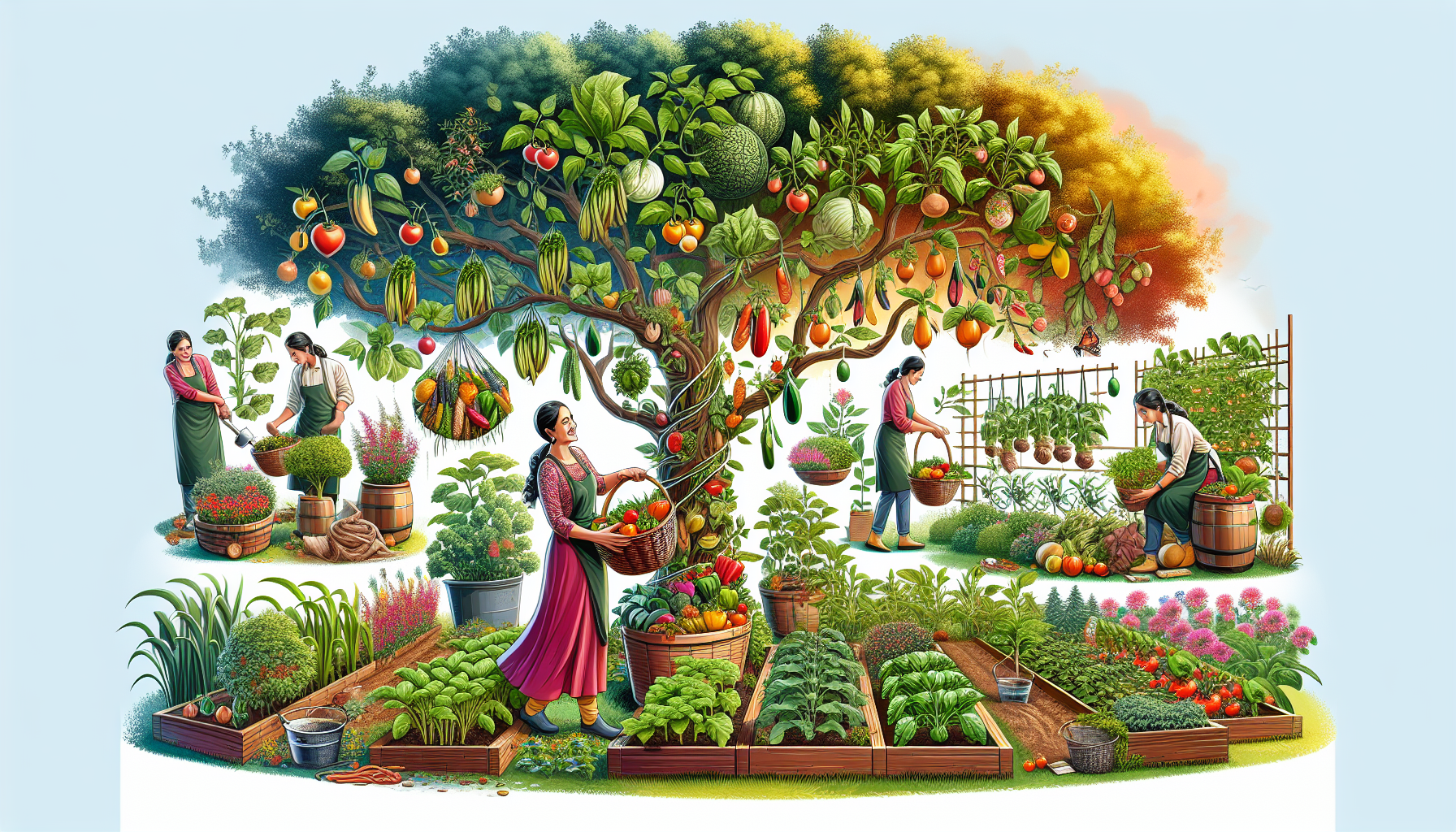Embark on a journey to green your thumb and nourish your soul with our comprehensive course on “How to Grow Your Own Organic Vegetable Garden”. This carefully crafted guide is designed to take you step by step through the process of transforming a small patch of earth into a thriving oasis of health and sustainability. From understanding the fundamentals of organic gardening, preparing and planting your garden, to the joys of harvesting your own pesticide-free produce, this course covers all the essential topics. Dive into the world of organic gardening and discover the secrets to cultivating a flourishing vegetable garden that benefits both you and the environment.
Lesson 1

Beginning Your Journey in Organic Gardening
Welcome to the enchanting world of organic gardening! This holistic approach not only brings you closer to nature but also ensures that your garden thrives without the use of synthetic chemicals. Organic gardening is about building a healthy ecosystem that supports the growth of vibrant vegetables and promotes biodiversity. In this guide, we will explore the foundational steps necessary to embark on your organic gardening adventure.
Understanding the Essence of Organic Gardening
Organic gardening is a method that emphasizes growing vegetables in harmony with nature. It relies on techniques that enhance soil health, conserve water, and encourage biodiversity. By avoiding synthetic fertilizers and pesticides, organic gardeners create a sustainable environment that is beneficial for both the garden and its surrounding ecosystem.
Choosing the Perfect Spot and Crafting Your Garden Plan
Location is paramount in organic gardening. Vegetables need ample sunlight to flourish, so select a spot that receives at least six hours of direct sunlight daily. Additionally, understanding your soil type is crucial as it determines water drainage and nutrient availability. Once you’ve chosen your site, it’s time to design your garden layout. Consider using companion planting to naturally repel pests and enhance growth.
Gathering Your Organic Gardening Tools
The right tools can make all the difference in your gardening experience. Start with the basics: a spade, garden fork, hoe, and watering can. Opt for quality tools that will last many seasons. Remember, maintaining your tools is just as important as using them, so clean and store them properly after each use.
Preparing Your Organic Garden
With your location selected and tools at the ready, the next step is to prepare your garden bed. Test your soil’s pH and nutrient levels to tailor your soil amendments. Adding organic compost is a fantastic way to enrich the soil, providing your plants with the nutrients they need to grow strong and healthy.
| Vegetable | Companion Plant | Benefits |
|---|---|---|
| Tomatoes | Basil | Repels pests and enhances flavor |
| Carrots | Chives | Deters carrot fly |
| Spinach | Strawberries | Conserves space and companionable growth |
Maintaining Your Organic Vegetable Garden
Consistent care is the key to a thriving organic garden. Regular weeding ensures your vegetables aren’t competing for nutrients. Water your plants in the early morning or late evening to minimize evaporation. Mulching is also beneficial, as it keeps the soil moist and suppresses weeds.
Creating a Sustainable Future Through Organic Gardening
Organic gardening is more than just a hobby; it’s a commitment to a healthier planet. As you tend to your garden, you’ll notice an increase in pollinators and beneficial insects, contributing to the ecological balance of your environment. Take pride in knowing that your organic garden not only yields delicious vegetables but also supports the Well-being of the planet.
By following these steps, you’re well on your way to creating a successful organic vegetable garden. Embrace the process, enjoy the journey, and celebrate the fruits (and vegetables) of your labor! Remember, every organic garden is a step towards a greener, more sustainable world.
Lesson 2

Taking Your Organic Vegetable Garden to the Next Level
Embarking on the journey of preparing and planting an organic vegetable garden is an exhilarating experience that connects you with nature and provides wholesome, home-grown produce. Organic gardening encourages you to work in harmony with the environment, cultivating a space that’s both productive and sustainable. This guide delves into the essential steps for enhancing your garden, focusing on soil preparation, vegetable selection, and effective planting techniques.
Enhancing Your Soil Organically
Healthy soil is the backbone of any successful organic garden. Begin with a thorough assessment of your soil’s pH and nutrient levels. Enriching your garden with organic compost significantly boosts soil health, offering your plants a rich source of nutrients. Consider incorporating aged manure, green compost, or leaf mold to introduce beneficial microorganisms and improve soil structure.
Selecting Suitable Vegetables for Your Garden
Choosing the right vegetables is crucial for a flourishing garden. Opt for varieties that are well-suited to your climate and season. Embrace diversity by including both heirloom and hybrid varieties in your garden. Heirloom seeds bring unique flavors and traditional gardening joy, while hybrids often offer disease resistance and enhanced vigor.
Mastering Planting Techniques
Whether you’re starting seeds indoors or direct sowing in the garden, understanding the nuances of planting will set you up for success. For seeds started indoors, ensure they are gradually acclimatized to outdoor conditions—a process known as hardening off—before transplanting. Direct sown seeds should be planted according to the depth and spacing guidelines. Remember, consistent watering and mulching play a pivotal role in the successful establishment of your plants.
| Vegetable | Planting Depth | Spacing |
|---|---|---|
| Tomatoes | 1/4 inch | 24-36 inches |
| Carrots | 1/4 inch | 2-3 inches |
| Green Beans | 1 inch | 6 inches |
Nurturing and Thwarting Pests Naturally
As your organic vegetables grow, keep a vigilant eye on them for pests. Employ natural methods such as introducing beneficial insects or using organic deterrents like neem oil. Furthermore, practicing companion planting can naturally repel pests while promoting a thriving garden environment.
Harvesting the Fruits of Your Labor
Harvesting at the right time is essential for the best flavor and nutrition. Each vegetable has its signs of ripeness, such as the deep, rich color of tomatoes or the firmness of cucumbers. Regular harvesting also encourages plants to produce more, extending your bounty throughout the growing season.
Conclusion: Celebrating Organic Gardening Achievements
Through careful planning, preparation, and planting, your organic vegetable garden will not only flourish but also become a sustainable source of joy and nutrition. Organic gardening is a rewarding journey that benefits both the gardener and the environment. Embrace the challenges and successes as you cultivate a healthier, greener world right in your backyard.
Lesson 3

Bringing Your Organic Vegetable Garden to Full Bloom
As your organic vegetable garden begins to flourish, the focus shifts to nurturing your burgeoning plants and ensuring they reach their full potential. An organic garden is more than just a source of fresh produce; it’s a dynamic ecosystem that supports a wide range of life. This guide will walk you through the essential steps of maintaining and harvesting your organic vegetable garden, emphasizing sustainable and eco-friendly practices that bolster plant health and productivity.
Promoting a Healthy Garden Ecosystem
Consistent attention and care are vital in an organic garden. Regular weeding prevents unwanted plants from competing with your vegetables for nutrients and water. Mulching plays a dual role, conserving moisture in the soil and suppressing weed growth. Watering is best done in the morning or late evening to reduce evaporation losses, providing your plants with the hydration they need to thrive.
Organic Pest Management and Pollination
Pests can be a challenge, but organic gardening offers several natural strategies to manage them. Encouraging beneficial insects by planting flowers or herbs that attract them can help control pest populations. Organic deterrents, such as neem oil and diatomaceous earth, are effective against pests while being safe for pollinators. Speaking of pollinators, ensure your garden is welcoming to bees, butterflies, and other beneficial insects by providing a diverse range of plants and avoiding the use of harmful chemicals.
Harvesting Your Organic Vegetables
Harvesting at the right time is crucial for getting the best flavor and nutritional value from your vegetables. Each type of vegetable has its indicators of ripeness. For example, tomatoes are best picked when evenly colored and slightly soft to the touch. Leafy greens, on the other hand, can be harvested when the leaves reach a size that suits your taste.
| Vegetable | Indicator of Ripeness | Harvesting Tip |
|---|---|---|
| Tomatoes | Evenly colored | Twist gently to remove |
| Lettuce | Leaves full-sized | Harvest in the morning |
| Carrots | Crown of root visible | Pull gently, avoiding damage |
Planning for the Future
As your garden progresses through the season, it’s essential to plan for the future. Rotating crops can help mitigate soil-borne diseases and nutrient depletion. Additionally, reflecting on the season’s successes and challenges prepares you for even greater success next year. Organic gardening is a continual learning process, an opportunity to grow alongside your garden.
Celebrating the Harvest and Beyond
The joy of organic gardening culminates in the harvest, but it extends far beyond that. Sharing your harvest with friends and family, saving seeds for next season, and even starting a compost bin for your garden waste are all ways to extend the lifecycle of your gardening efforts. Organic gardening connects us to the cycles of nature, offering profound insights and rewarding us with its bounty.
With patience, care, and a little bit of effort, your organic vegetable garden will not only provide a source of delicious, home-grown vegetables but also serve as a sanctuary for local wildlife, and a testament to the sustainability and productivity of organic gardening practices. Here’s to the fruits of your labor and to the many seasons of gardening success to come.
Organic vegetable gardening concludes as a rewarding journey that not only fulfills the desire for fresh, home-grown produce but also fosters a deep connection with nature. Throughout this course, we’ve covered everything from planning and preparing your garden to the joys of harvesting. Armed with knowledge on soil health, pest management, and sustainable gardening practices, you’re now ready to turn any space into a green haven. Remember, the success of your organic vegetable garden grows with you over time, as each season offers new lessons and opportunities for growth. To solidify your understanding and ensure you’re ready to embark on your gardening adventure, don’t forget to take the 10-question quiz below. This is your chance to test your knowledge and confidently grow into the organic gardener you aspire to be.
Test Your Knowledge With this short Quiz
Click here to copy your score to share on facebook!







